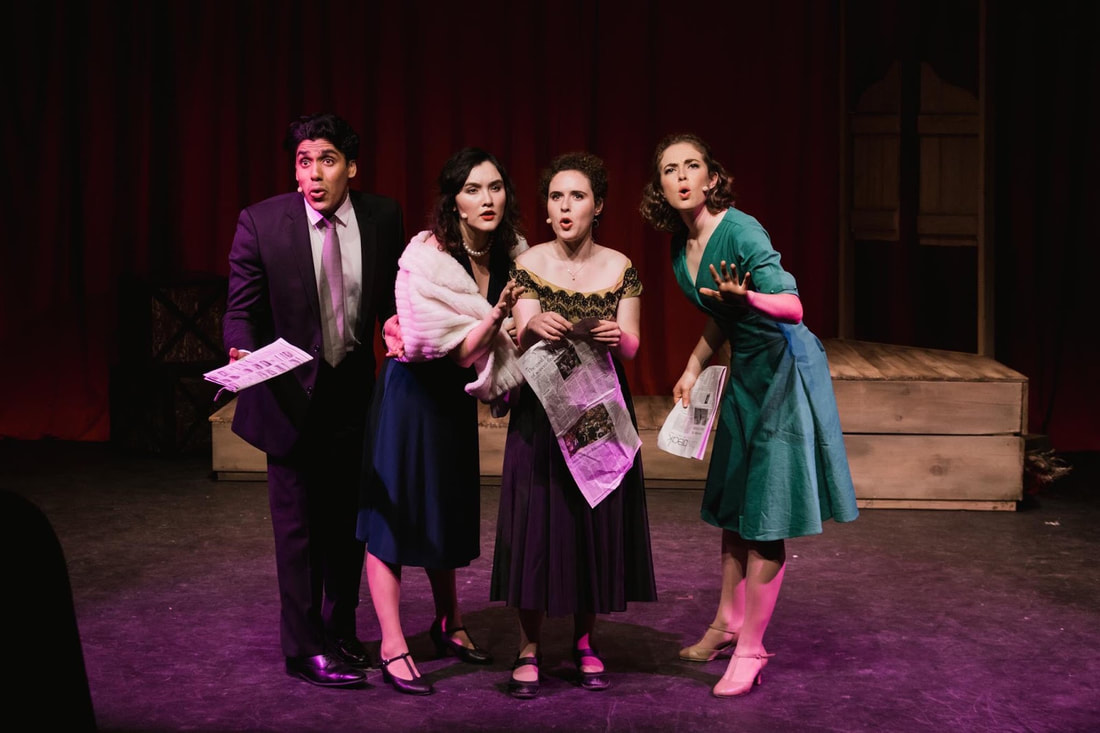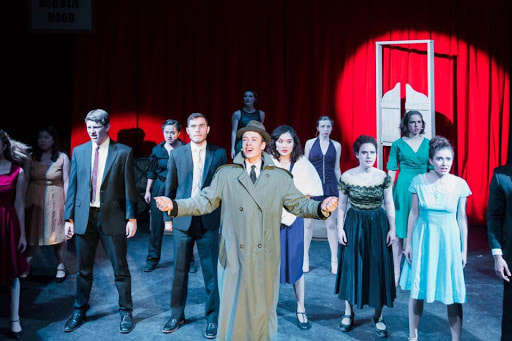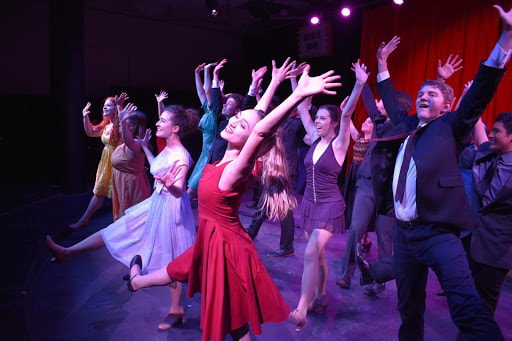|
BareStage Performers in Curtains By Katherine Schloss One of the major theatrical production organizations on campus is BareStage Productions. They pride themselves on providing pre-professional opportunities for students to get involved in every aspect of the theatrical process. I personally watched their production of Cabaret last semester and was impressed by the dark depth of the story that they were able to convey to the audience through their performance and storytelling. I interviewed Eliana Adise, the managing director of BareStage, to get a better feel for the organization in its massive appeal to the student body. When asked about the history of BareStage, Eliana said that, “BareStage was founded in 1994 by Ben Rimalower. It was always intended to be student-run theatre but it has expanded in size and production value since its beginnings. There are many opportunities for students to get involved in BareStage. We put on four productions a year- two plays and two musicals. Students can get involved in any of these four productions as actors, production team, orchestra, designers, and directors. Outside of these productions, students can also get involved in BareTroupe, our musical theatre ensemble, gain technical experience at our Build Days or by shadowing senior members of our company. Finally, students can get involved in our Board of Directors and Company Member positions and gain much of the experience one would typically encounter in running a professional theatre company (on a smaller scale).” This semester, Barestage put on two productions: 1984, an adaptation of George Orwell’s dystopian novel, and Curtains, a comedic murder mystery musical within a musical. Ethan Glasman made his directorial debut for Curtains, and the students had their passionate efforts rewarded when they sold out their second weekend of shows despite having to reschedule due to the poor air quality in Berkeley. As managing director, Eliana oversees the Board of Directors and helps to refine their artistic visions so that they can become a reality. Eliana brings up the fascinating concept of how plays and musicals that were written in a completely different time period can be revived or can be used as a vessel for providing commentary on the current state of things as well as for showing how history can repeat itself. She says, “To me, the magic of live theatre is its inability to be archived. Each performance differs as artists learn and grow and as audiences experience the show for the first time. When we choose our season, every show carries a new message with it; a reflection of the flaws we see in the world, idealization of the world that can be, an escape to the fantastical imaginings of art itself. Several shows we’ve put on recently, Curtains and Noises Off, have been shows within a show. So on one hand, you have this escape from everyday reality and on the other hand, you have an honest reflection of the world artists live in and the work they produce. That’s what I love about theatre. Artists that so willingly bare their soul to comment on society.” In this way, performances within the theater are also so incredibly personal, and though you sit and have an experience with the mass of people that surround you in the audience, each individual also has their own unique take-away from the show and approaches the messages differently based on their own life experiences. BareStage performers in their production of Curtains I also was able to get some perspective from Walker Heintz, who has both acted with Barestage as well as being involved as a dramaturg. He says that what may seem like a grueling amount of rehearsals - 4 hours a day, six days a week - became a positive thing to look forward to at the end of the day. He cites BareStage as being a good place for first timers to express themselves and to “try something new on the stage,” as well as a space for “anyone looking to express their creative side.” He felt that seeing how their art affected the audience was “one of the most rewarding things” that he has done at Berkeley. Experiencing the thrill of being onstage and then being involved in the creative process the next time around gave him a very well-rounded perspective. Of that he said that he found being able to “witness the creative aspects of organizing and fulfilling the creativity of the actors and actresses on the stage” to be a “completely different reward in itself.” He says that BareStage is a tremendous experience for anyone looking for an outlet at a school as big as Berkeley! BareStage performers in Curtains BareStage Performers in 1984
0 Comments
By Jack Wareham Dedicated to those filmmakers too often branded as ‘slow.’ Bresson, Ozu, Tarkovsky, Antonioni, Tati, Kubrick … Describing the speed of a film is one of the most common metrics we have of assessing cinematic technique. We’re told that fast-paced films are thrilling entertainment or popcorn flicks. Slow films, in contrast, are more likely to be a part of ‘art cinema,’ and for many, sitting through them is a duty rather than a pleasure. But what do we really mean when we describe a film as slow? After all, every film moves with the same speed: twenty-four frames a second. I think the adjectives ‘slow’ and ‘fast’ are often used incorrectly to describe films, and should ideally depart the vocabulary of film discussions. 1. The most obvious problem with discussing whether a film is slow or fast is that speed is entirely dependent on the viewer. To a movie-goer in 1941, Citizen Kane was likely a wildly sensational experience, but to someone growing up on Snapchat stories and Vines it might be a dreadful slog. 2. Maybe speed is a descriptor of the number of plot points, or the rapidity with which one plot point leads to the next. But consider Barry Lyndon, a movie deemed ‘slow’ by its detractors, which spans a man’s entire life and his rise and fall from fortune. It can’t be a matter of dialogue either: for a recent example, think of A Quiet Place, which was deemed a thrilling movie by many despite having almost no conversation between characters. 3. A more precise measure of speed could be a film’s Average Shot Length in seconds, or ASL. And yet in my High School film class some students described Eisenstein’s Battleship Potemkin as slow despite its ASL being only 3 seconds, compared to Michael Bay’s 3 and Steven Spielberg’s 6.5. 4. In their current form, discussions of speed in film tend to privilege plot over form and new films over old ones. I think what people really mean by ‘slow’ and ‘fast’ is the speed from which a film moves from one meaningful moment to the next. As such, the real question is not the pacing of the plot or the length of the shots, but how often we find ourselves captivated or astonished. If you find rapturous pleasure in the long space sequences in 2001, or the melancholy zoom-outs in Barry Lyndon, there is no need to describe them as ‘slow.’ To quote Jonathan Rosenbaum in his discussion of the speed of Yasujiro Ozu’s films: “For what finally matters most in Ozu is not how slow or fast he is but how slow or fast we are in keeping up with him.” |
Archives
March 2024
Writers
All
|



